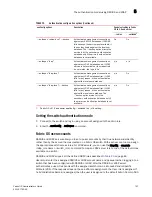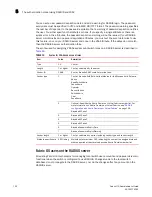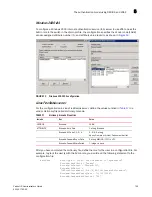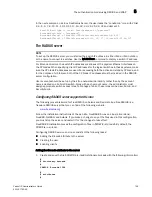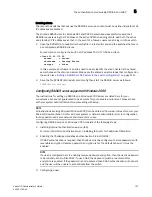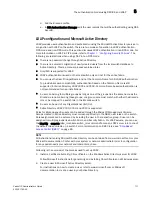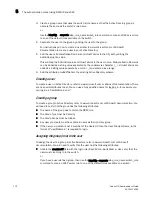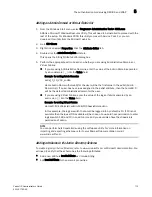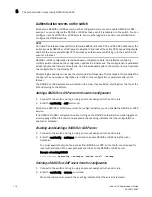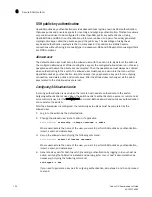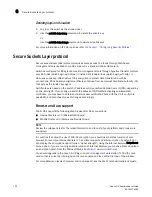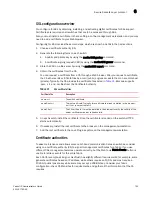
Fabric OS Administrator’s Guide
115
53-1001763-02
The authentication model using RADIUS and LDAP
5
Changing a RADIUS or LDAP server configuration
1. Connect to the switch and log in using an account assigned to the admin role.
2. Enter the aaaConfig
--
change
command.
Changing the order in which RADIUS or LDAP servers are contacted for service
1. Connect to the switch and log in using an account assigned to the admin role.
2. Enter the aaaConfig
--
move
command.
When the command succeeds, the event log indicates that a server configuration is changed.
Displaying the current RADIUS configuration
1. Connect to the switch and log in using an account assigned to the admin role.
2. Enter the aaaConfig
--
show
command.
If a configuration exists, its parameters are displayed. If RADIUS or LDAP service is not
configured, only the parameter heading line is displayed. Parameters include:
Configuring local authentication as backup
It is useful to enable local authentication so that the switch can take over authentication locally if
the RADIUS or LDAP servers fail to respond because of power outage or network problems.
Example of enabling local authentication, enter the following command for RADIUS
switch:admin>
aaaconfig --authspec "radius;local" --backup
Example for LDAP
switch:admin>
aaaconfig --authspec "ldap;local" --backup
For details about this command see
Table 15
on page 100.
When local authentication is enabled and the RADIUS or LDAP servers fail to respond, you can log
in to the default switch accounts (admin and user) or any user-defined account. You must know the
passwords of these accounts.
When the command succeeds, the event log indicates that local database authentication is
disabled or enabled.
Position
The order in which servers are contacted to provide service.
Server
The server names or IPv4 or IPv6 addresses. IPv6 is not supported when using PEAP
authentication.
Port
The server ports.
Secret
The shared secrets.
Timeouts
The length of time servers have to respond before the next server is contacted.
Authentication
The type of authentication being used on servers.
Summary of Contents for 53-1001763-02
Page 1: ...53 1001763 02 13 September 2010 Fabric OS Administrator s Guide Supporting Fabric OS v6 4 0 ...
Page 4: ...iv Fabric OS Administrator s Guide 53 1001763 02 ...
Page 24: ...xxiv Fabric OS Administrator s Guide 53 1001763 02 ...
Page 28: ...xxviii Fabric OS Administrator s Guide 53 1001763 02 ...
Page 32: ...xxxii Fabric OS Administrator s Guide 53 1001763 02 ...
Page 40: ...xl Fabric OS Administrator s Guide 53 1001763 02 ...
Page 42: ...2 Fabric OS Administrator s Guide 53 1001763 02 ...
Page 54: ...14 Fabric OS Administrator s Guide 53 1001763 02 High availability of daemon processes 1 ...
Page 74: ...34 Fabric OS Administrator s Guide 53 1001763 02 Basic connections 2 ...
Page 102: ...62 Fabric OS Administrator s Guide 53 1001763 02 Audit log configuration 3 ...
Page 214: ...174 Fabric OS Administrator s Guide 53 1001763 02 Management interface security 7 ...
Page 228: ...188 Fabric OS Administrator s Guide 53 1001763 02 Brocade configuration form 8 ...
Page 276: ...236 Fabric OS Administrator s Guide 53 1001763 02 Creating a logical fabric using XISLs 10 ...
Page 404: ...364 Fabric OS Administrator s Guide 53 1001763 02 ...
Page 440: ...400 Fabric OS Administrator s Guide 53 1001763 02 Performance data collection 17 ...
Page 480: ...440 Fabric OS Administrator s Guide 53 1001763 02 F_Port masterless trunking 19 ...
Page 494: ...454 Fabric OS Administrator s Guide 53 1001763 02 Buffer credit recovery 20 ...
Page 574: ...534 Fabric OS Administrator s Guide 53 1001763 02 Hexadecimal overview E ...

